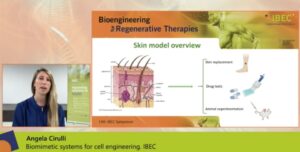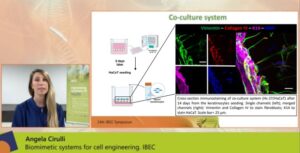Last 27th and 28th of October took place the 14th IBEC Symposium, completely online due to COVID-19 pandemic restrictions. This year, the event focused on Regenerative Therapies and how the latest scientific advances in mini-organs, organs on a chip, 3D bioprinting and tissue engineering can help to address the problem of tissue demand for organ transplantation and replacement, and for experimentation for new drugs development. The symposium counted with the participation of more than 300 registered attendees, including renowned speakers from Europe and the USA as Jennifer A. Lewis from Harvard University, Frank P. Luyten, director of the Skeletal Biology and Engineering Research Center at Belgium, and Eva Van Rooij from the Hubrecth Institute in The Netherlands.

In the frame of this symposium, Angela Cirulli, predoctoral researcher at the Biomimetic Systems for Cell Engineering from the Institute for Bioengineering of Catalonia (IBEC), presented the last advances of the BRIGHTER project on 3D bioprinting and the development of a skin model. She presented a poster on a virtual space and was one of the 17 researchers selected to show her work also on a flash talk. Concretely, she talked about “Photo-crosslinkable hydrogels for skin model reconstruction” and presented the latest results regarding hydrogels obtained at the Biomimetic Systems for Cell Engineering group at IBEC in close collaboration with one of the industrial partners of the project, Cellendes.

Angela presented BRIGHTER’s novel approach based on visible-light 3D bioprinting system to produce skin tissue models as similar as possible to a real structure. One of the main limitations of working with skin tissue engineered models is to obtain a faithful replica of this heterologous and complex organ that could be used for skin replacement and drug testing (avoiding animal experimentation) among other purposes. In this context, photo-crosslinkable hydrogels are the best candidates to mimic the perfect skin cells microenvironment, due to their biocompatibility and their tuneable properties. In BRIGHTER project, researchers are using norbornene based hydrogels with the aim to construct a skin model with improved properties.

She explained the polymerization process and presented immunostaining results showing the formation of two different cellular compartments, mimicking both the dermis (top layer) and the epidermis (bottom layer). To do so, representative skin cellular types were included on the hydrogels (some cells seeded on top and others included within) and co-cultured for several days, showing a high cell viability and uniform distribution. Moreover, she also described a higher production of extracellular matrix proteins of co-cultured inside the hydrogel, revealing crosstalk among them.
“These promising results do not only demonstrate the good compatibility between cells and the hydrogel structure but are also tracing an excellent pattern to reach a final skin model”
Angela Cirulli